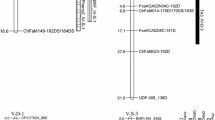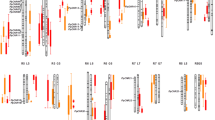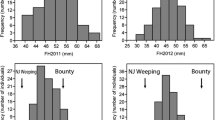Abstract
Despite their economic importance, some tropical crop species are largely neglected when it comes to conducting genetic studies characterizing target traits for breeding. Herein, genetic and phenotypic parameters as well quantitative trait loci (QTL) are described for the first time in a full-sib progeny of sweet passion fruit (Passiflora alata). A hundred F1 individuals were evaluated in two locations for seven fruit traits: diameter of fruit (DF, in mm), length of fruit (LF, in mm), weight of fruit (WF, in g), thickness of fruit skin (TS, in mm), weight of fruit skin (WS, in g), weight of fruit pulp (WP, in g) and soluble solids (SS, in °Brix). Mixed models fitted complex, unstructured genetic variance-covariance matrices for all traits in phenotypic analysis. Because of important genetic correlations among skin and pulp traits, multiplicative index selection to select the most promising individuals was successfully applied. A previously reported integrated map supported composite interval mapping (CIM) analyses. In total, we found 22 QTLs mapped in seven out of nine linkage groups. Heritabilities (from 59.8 % to 82.7 %) and proportion of phenotypic variance explained by the QTLs (from 42.0 % to 64.3 %) were comparable for each trait. Principal component analysis on TS, WS and WP showed that the first two principal components (PCs) accounted for 93.6 % of the total variability. CIM analyses on these two PCs revealed five putative QTLs controlling variation for these three traits simultaneously. Thus, genetic improvement for sweet passion fruit should be based on correlations between traits and QTL-related information can be a useful tool.


Similar content being viewed by others
Abbreviations
- AFLP:
-
Amplified fragment length polymorphism
- AIC:
-
Akaike information criterion
- BIC:
-
Bayesian information criterion
- CIM:
-
Composite interval mapping
- DF:
-
Diameter of fruit
- GEI:
-
Genotype-environment interaction
- LF:
-
Length of fruit
- LG:
-
Linkage groups
- LOD:
-
Logarithm of the odds
- MI:
-
Multiplicative index
- PC:
-
Principal component
- PCA:
-
Principal component analysis
- QTL:
-
Quantitative trait loci
- REML:
-
Restricted maximum likelihood
- RS:
-
Response to selection
- RS%:
-
Response to selection in percentage
- SD:
-
Selection differential
- SS:
-
Total soluble solids
- TS:
-
Thickness of fruit skin
- VCOV:
-
Variance-covariance
- WF:
-
Weight of fruit
- WP:
-
Weight of fruit pulp
- WS:
-
Weight of fruit skin
References
Akaike H (1974) A new look at the statistical model identification. Trans on Automat Contr 19:716–723
Alseekh S, Tohge T, Wendenberg R, Scossa F, Omranian N, Li J, Kleessen S, Giavalisco P, Pleban T, Mueller-Roeber B, Zamir D, Nikoloski Z, Fernie AR (2015) Identification and mode of inheritance of quantitative trait loci for secondary metabolite abundance in tomato. Plant Cell 27:485–512
Bruckner CH, Casali VWD, Moraes CF, et al. (1993) Self-incompatibility in passion fruit (Passiflora edulis Sims). ISHS. Acta Hortic 370:45–58
Causse M, Saliba-Colombani V, Lecomte L, et al. (2002) QTL analysis of fruit quality in fresh market tomato: a few chromosome regions control the variation of sensory and instrumental traits. J Exp Bot 53:2089–2098
Cerqueira-Silva CB, Jesus ON, Santos ES, et al. (2014) Genetic breeding and diversity of the genus Passiflora: progress and perspectives in molecular and genetic studies. Int J Mol Sci 15:14122–14152
Chang Y, Sun R, Sun H, et al. (2014) Mapping of quantitative trait loci corroborates independent genetic control of apple size and shape. Sci Hortic 174:126–132
Chen L, Storey JD (2006) Relaxed significance criteria for linkage analysis. Genetics 173:2371–2381
Chen FQ, Foolad MR, Hyman J, et al. (1999) Mapping of QTLs for lycopene and other fruit traits in a Lycopersicon esculentum × L. pimpinellifolium cross and comparison of QTLs across tomato species. Mol Breed 5:283–299
Churchill GA, Doerge RW (1994) Empirical threshold values for quantitative trait mapping. Genetics 138:963–971
Cuco SM, Vieira MLC, Mondin M, et al. (2005) Comparative karyotype analysis of three Passiflora L. Species and cytogenetic characterization of somatic hybrids. Caryologia 58:220–228
Da Costa e Silva L, Wang S, Zeng ZB (2012) Multiple trait multiple interval mapping of quantitative trait loci from inbred line crosses. BMC Genet 13:67
Dhawan K, Dhawan S, Sharma A (2004) Passiflora: a review update. J Ethnopharmacol 94:1–23
Eduardo I, Pacheco I, Chietera G, et al. (2011) QTL analysis of fruit quality traits in two peach intraspecific populations and importance of maturity date pleiotropic effect. Tree Genet Genomes 7:323–335
Elston RC (1963) A weight-free index for the purpose of ranking or selection with respect to several traits at a time. Biometrics 19:85–97
Ferreira TG, Penha HA, Zucchi MI, et al. (2010) Outcrossing rate in sweet passion fruit based on molecular markers. Plant Breed 129:727–730
Gazaffi R, Margarido GRA, Pastina MM, et al. (2014) A model for quantitative trait loci mapping, linkage phase, and segregation pattern estimation for a full-sib progeny. Tree Genet Genomes 10:791–801
Gonçalves GM, Viana AP, Bezerra Neto FV, et al. (2007) Selection and heritability in the prediction of genetic gain in yellow passion fruit. Pesq Agropec Bras 42:193–198
Grattapaglia D, Sederoff R (1994) Genetic linkage maps of Eucalyptus grandis and Eucalyptus urophylla using a pseudo-testcross: mapping strategy and RAPD markers. Genetics 1137:1121–1137
Holland JB, Nyquist WE, Cervantes-Martínez CT (2003) Estimating and interpreting heritability for plant breeding: An update. In: Janick J (ed) Plant breeding reviews, vol 22. Wiley, New Jersey, pp. 9–112
IBGE (2013) Produção agrícola municipal: Culturas temporárias e permanentes. Instituto Brasileiro de Geografia e Estatística, Rio de Janeiro, vol 40 pp 1–102
Ingale A, Hivrale A (2010) Pharmacological studies of Passiflora sp. and their bioactive compounds. African J Plant Sci 4:417–426
Kenis K, Keulemans J, Davey MW (2008) Identification and stability of QTLs for fruit quality traits in apple. Tree Genet Genomes 4:647–661
Klein N, Gazola AC, de Lima TC, Schenkel E, et al. (2014) Assessment of sedative effects of Passiflora edulis f. flavicarpa and Passiflora alata extracts in mice, measured by telemetry. Phytother Res 28:706–713
Madureira HC, Pereira TNS, Cunha M, et al. (2014) Self-incompatibility in passion fruit: cellular responses in incompatible pollinations. Biologia 69:574–584
Malosetti M, Ribaut J-M, van Eeuwijk FA (2013) The statistical analysis of multi-environment data: modeling genotype-by-environment interaction and its genetic basis. Front Physiol 4:44
Margarido GRA, Souza AP, Garcia AAF (2007) OneMap: software for genetic mapping in outcrossing species. Hereditas 144:78–79
Mollinari M, Margarido GRA, Vencovsky R, et al. (2009) Evaluation of algorithms used to order markers on genetic maps. Heredity 103:494–502
Moraes MC, Geraldi IO, Matta FP, et al. (2005) Genetic and phenotypic parameter estimates for yield and fruit quality traits from a single wide cross in yellow passion fruit. Hortscience 40:1978–1981
Munhoz CF, Santos AA, Arenhart RA, et al. (2015) Analysis of plant gene expression during passion fruit–Xanthomonas axonopodis interaction implicates lipoxygenase 2 in host defence. Ann App Biol 167:135–155
Nocker S, Gardiner SE (2014) Breeding better cultivars, faster: applications of new technologies for the rapid deployment of superior horticultural tree crops. Horticulture Research 1: Article number 14022
Oliveira EJ, Vieira MLC, Garcia AAF, et al. (2008a) An integrated molecular map of yellow passion fruit based on simultaneous maximum-likelihood estimation of linkage and linkage phases. J Amer Soc Hort Sci 133:35–41
Oliveira EJ, Santos VS, Lima DS, et al. (2008b) Selection on yellow passion fruit progenies by multivariate indices. Pesq Agropec Bras 43:1543–1549
Penha HA, Pereira GDS, Zucchi MI, et al. (2013) Development of microsatellite markers in sweet passion fruit, and identification of length and conformation polymorphisms within repeat sequences. Plant Breed 132:731–735
Pereira GS, Nunes ES, Laperuta LDC, et al. (2013) Molecular polymorphism and linkage analysis in sweet passion fruit, an outcrossing species. Ann Appl Biol 162:347–361
Potts SM, Khan MA, Han Y, et al. (2013) Identification of quantitative trait loci (QTLs) for fruit quality traits in apple. Plant Mol Biol Rep 32:109–116
Ray PK (2002) Breeding tropical and subtropical fruits. Springer-Verlag, Narosa
Rosado LDS, Santos CEM, Bruckner CH, et al. (2012) Simultaneous selection in progenies of yellow passion fruit using selection indices. Rev Ceres 59:95–101
Saliba-Colombani V, Causse M, Langlois D, et al. (2001) Genetic analysis of organoleptic quality in fresh market tomato. 1. Mapping QTLs for physical and chemical traits. Theor Appl Genet 102:259–272
Santos AA, Penha HA, Bellec A (2014) Begin at the beginning: a BAC-end view of the passion fruit (Passiflora) genome. BMC Genomics 15:816
Schwarz G (1978) Estimating the dimension of a model. Ann Statist 6:461–464
Silva MGM, Viana AP, Gonçalves GM, et al. (2009) Intrapopulation recurrent selection in yellow passion fruit: Alternative to accumulate genetic gains. Ciênc Agrotec 33:170–176
Silva FHL, Muñoz PR, Vincent CI, Viana AP (2016) Generating relevant information for breeding Passiflora edulis: genetic parameters and population structure. Euphytica 208:609–619
Souza MM, Pereira TNS, Vieira MLC (2008) Cytogenetic studies in some species of Passiflora L. (Passifloraceae): a review emphasizing Brazilian species. Braz Arch Biol Technol 51:247–258
Suassuna TMF, Bruckner H, Carvalho CR, Borém A (2003) Self-incompatibility in passionfruit: evidence of gametophytic-sporophytic control. Theor Appl Genet 106:298–302
VSN International (2014) GenStat for Windows 16th Edition. VSN International, Hemel Hempstead http://www.vsni.co.uk
Wu R, Ma C-X, Painter I, Zeng Z-B (2002a) Simultaneous maximum likelihood estimation of linkage and linkage phases in outcrossing species. Theor Popul Biol 61:349–363
Wu R, Ma C-X, SS W, Zeng Z-B (2002b) Linkage mapping of sex-specific differences. Genet Res 79:85–96
Zeng Z-B (1994) Precision mapping of quantitative trait loci. Genetics 136:1457–1468
Zhang G, Sebolt AM, Sooriyapathirana SS, et al. (2009) Fruit size QTL analysis of an F1 population derived from a cross between a domesticated sweet cherry cultivar and a wild forest sweet cherry. Tree Genet Genomes 6:25–36
Zhang RP, Wu J, Li XG, et al. (2013) An AFLP, SRAP, and SSR genetic linkage map and identification of QTLs for fruit traits in pear (Pyrus L. Plant Mol Biol Report 31:678–687
Acknowledgments
The authors wish to thank the Fundação de Amparo à Pesquisa do Estado de São Paulo (FAPESP, Brazil) for its financial support and the fellowships awarded to GSP, MMP and RG. Our thanks also to the Conselho Nacional de Desenvolvimento Científico e Tecnológico (CNPq, Brazil) for the fellowships awarded to PhD students (ESN and LDCL) and researchers (IOG, AAFG and MLCV). Finally, we would also like to thank Carlos A. de Oliveira for his excellent technical assistance, Mr. H. Borgonove for providing an experimental area on his private farm at Descalvado, Brazil and Mr. Steve Simmons for proofreading the manuscript.
Author information
Authors and Affiliations
Corresponding author
Ethics declarations
Conflict of Interest
The authors declare no conflict of interest.
Additional information
Communicated by: Yann-Rong Lin
Electronic supplementary material
12042_2016_9181_MOESM1_ESM.tif
Logarithm of the odds ratio (LOD) score profiles of composite interval mapping (CIM) for seven fruit traits in a sweet passion fruit full-sib progeny. LOD score profiles of CIM for the first (PC1) and second (PC2) principal components on TS, WS and WP are also given. Numbers above the peaks indicate QTLs declared based on the threshold (‘thr’) values obtained from permutation for each trait (TIFF 848 kb)
12042_2016_9181_MOESM2_ESM.tif
Biplot of the first (PC1) and second (PC2) principal components on thickness of fruit skin (TS, in mm), weight of fruit skin (WS, in g), and weight of fruit pulp (WP, in g) in a sweet passion fruit full-sib population. Numbers indicate the rank of full-sibs selected by multiplicative index selection; plus signs (+) indicate the remaining (non-selected) full-sibs (TIFF 396 kb)
ESM 3
(DOCX 13 kb)
ESM 4
(DOCX 14 kb)
Rights and permissions
About this article
Cite this article
da Silva Pereira, G., Di Cassia Laperuta, L., Nunes, E.S. et al. The Sweet Passion Fruit (Passiflora alata) Crop: Genetic and Phenotypic Parameter Estimates and QTL Mapping for Fruit Traits. Tropical Plant Biol. 10, 18–29 (2017). https://doi.org/10.1007/s12042-016-9181-4
Received:
Accepted:
Published:
Issue Date:
DOI: https://doi.org/10.1007/s12042-016-9181-4




